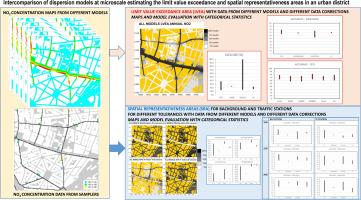应用微尺度模型估算城市空气质量监测站的空气质量超标面积和空间代表性
IF 8
1区 环境科学与生态学
Q1 ENVIRONMENTAL SCIENCES
引用次数: 0
摘要
本研究基于在比利时安特卫普一个地区进行的FAIRMODE相互比较的结果,该地区有一个全面的空气污染物测量数据集(空气质量站和被动采样器)。通过几个分散模拟系统(Martín等人,2024)估算了非常高空间分辨率的长期平均NO2浓度,以研究这些系统在城市环境微观尺度上捕获NO2浓度详细空间分布的能力。在后续研究中,我们通过评估这些建模系统预测两个参考空气质量站NO2年限值超标区域(LVEAs)和空间代表性区域(sra)的能力来扩展分析。所使用的不同建模方法基于CFD、拉格朗日、高斯和人工智能驱动模型。不同的建模方法一般都能很好地预测城市空气质量站的LVEA和SRA,尽管较小的SRA(对应于低浓度容差或交通站点)更难正确预测。然而,在建模系统之间存在着显著的性能差异。基于CFD模型的模型似乎提供了更一致的预测lvea和sra的结果。基于人工智能的系统、拉格朗日模型和具有街道峡谷参数化的高斯模型精度较低。采用街道-峡谷参数化的高斯模型明显优于单纯采用高斯色散参数化的模型。此外,非定常全月CFD模拟得到的LVEA和SRA估算值与基于场景的CFD模拟方法得到的LVEA和SRA估算值的大部分统计指标差异不大,但LVEA和SRA(交通站点,10%容差)大小存在显著差异。情景的数量似乎与结果无关。探讨了不同的偏差校正方法。本文章由计算机程序翻译,如有差异,请以英文原文为准。

Estimating the air quality standard exceedance areas and the spatial representativeness of urban air quality stations applying microscale modelling
This study builds upon the findings of a FAIRMODE intercomparison exercise conducted in a district of Antwerp, Belgium, where a comprehensive dataset of air pollutant measurements (air quality stations and passive samplers) was available. Long-term average NO2 concentrations at very high spatial resolution were estimated by several dispersion modelling systems (Martín et al., 2024) to investigate the ability of these to capture the detailed spatial distribution of NO2 concentrations at the microscale in urban environments. In this follow-up research, we extend the analysis by evaluating the capability of these modelling systems to predict the NO2 annual limit value exceedance areas (LVEAs) and spatial representativeness areas (SRAs) for NO₂ at two reference air quality stations. The different modelling approaches used are based on CFD, Lagrangian, Gaussian, and AI-driven models.
The different modelling approaches are generally good at predicting the LVEA and SRAs of urban air quality stations, although a small SRA (corresponding to low concentration tolerances or the traffic station) is more difficult to predict correctly. However, there are notable differences in performance among the modelling systems. Those based on CFD models seem to provide more consistent results predicting LVEAs and SRAs. Then, lower accuracy is obtained with AI-based systems, Lagrangian models, and Gaussian models with street canyon parameterizations. The Gaussian models with street-canyon parametrizations show significantly better results than models using simply a Gaussian dispersion parametrization.
Furthermore, little differences are observed in most of the statistical indicators corresponding to the LVEA and SRA estimates obtained from the unsteady full month CFD simulations compared to those from the scenario-based CFD simulation methodologies, but there are some noticeable differences in the LVEA or SRA (traffic station, 10 % tolerance) sizes. The number of scenarios does not seem to be relevant to the results. Different bias correction methodologies are explored.
求助全文
通过发布文献求助,成功后即可免费获取论文全文。
去求助
来源期刊

Science of the Total Environment
环境科学-环境科学
CiteScore
17.60
自引率
10.20%
发文量
8726
审稿时长
2.4 months
期刊介绍:
The Science of the Total Environment is an international journal dedicated to scientific research on the environment and its interaction with humanity. It covers a wide range of disciplines and seeks to publish innovative, hypothesis-driven, and impactful research that explores the entire environment, including the atmosphere, lithosphere, hydrosphere, biosphere, and anthroposphere.
The journal's updated Aims & Scope emphasizes the importance of interdisciplinary environmental research with broad impact. Priority is given to studies that advance fundamental understanding and explore the interconnectedness of multiple environmental spheres. Field studies are preferred, while laboratory experiments must demonstrate significant methodological advancements or mechanistic insights with direct relevance to the environment.
 求助内容:
求助内容: 应助结果提醒方式:
应助结果提醒方式:


